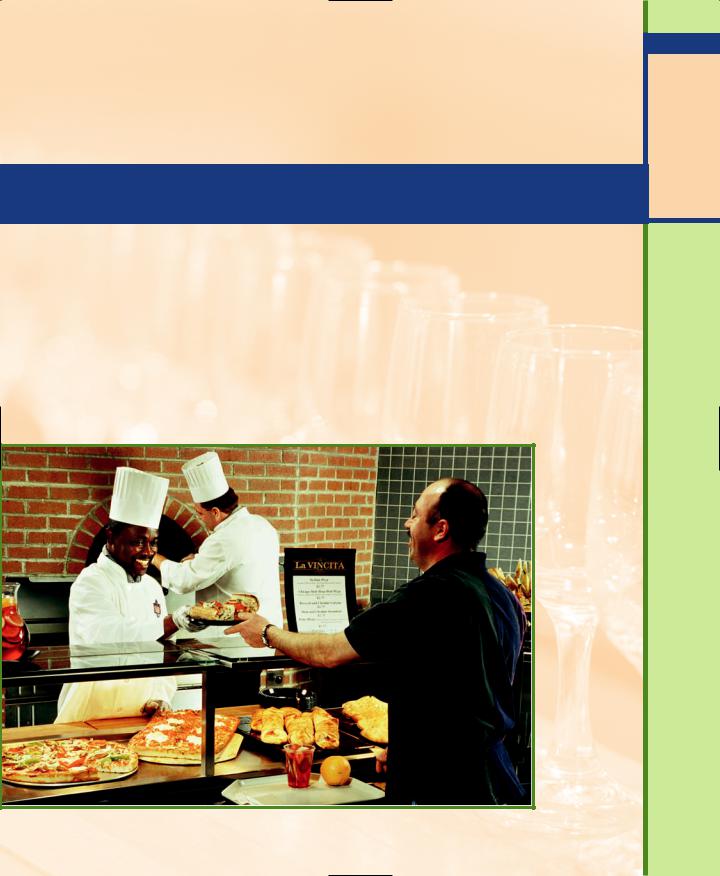
- •CONTENTS
- •PREFACE
- •Content—Benefits for Students
- •Content—Benefits for Instructors
- •Features of the Book for Students and Instructors
- •Supplementary Materials
- •Acknowledgments
- •What Is Hospitality Management?
- •The Manager’s Role in the Hospitality Industry
- •Why Study in a Hospitality Management Program?
- •Planning a Career
- •Employment as an Important Part of Your Education
- •Getting a Job
- •Employment at Graduation
- •The Outlook for Hospitality
- •Summary
- •Managing Change
- •Demand
- •Supply
- •Workforce Diversity
- •The Impact of Labor Scarcity
- •Summary
- •The Varied Field of Food Service
- •The Restaurant Business
- •The Dining Market and the Eating Market
- •Contemporary Popular-Priced Restaurants
- •Restaurants as Part of a Larger Business
- •Summary
- •Restaurant Operations
- •Making a Profit in Food Service Operations
- •Life in the Restaurant Business
- •Summary
- •Chain Restaurant Systems
- •Independent Restaurants
- •Franchised Restaurants
- •Summary
- •Competitive Conditions in Food Service
- •The Marketing Mix
- •Competition with Other Industries
- •Summary
- •Self-Operated Facilities
- •Managed-Services Companies
- •Business and Industry Food Service
- •College and University Food Service
- •Health Care Food Service
- •School and Community Food Service
- •Other Segments
- •Vending
- •Summary
- •Consumer Concerns
- •Food Service and the Environment
- •Technology
- •Summary
- •The Evolution of Lodging
- •Classifications of Hotel Properties
- •Types of Travelers
- •Anticipating Guest Needs in Providing Hospitality Service
- •Service, Service, Service
- •Summary
- •Major Functional Departments
- •The Rooms Side of the House
- •Hotel Food and Beverage Operations
- •Staff and Support Departments
- •Income and Expense Patterns and Control
- •Entry Ports and Careers
- •Summary
- •The Economics of the Hotel Business
- •Dimensions of the Hotel Investment Decision
- •Summary
- •The Conditions of Competition
- •The Marketing Mix in Lodging
- •Product in a Segmented Market
- •Price and Pricing Tactics
- •Place—and Places
- •Promotion: Marketing Communication
- •Summary
- •The Importance of Tourism
- •Travel Trends
- •The Economic Significance of Tourism
- •The United States as an International Tourist Attraction
- •Businesses Serving the Traveler
- •Noneconomic Effects of Tourism
- •Summary
- •Motives and Destinations
- •Mass-Market Tourism
- •Planned Play Environments
- •Casinos and Gaming
- •Urban Entertainment Centers
- •Temporary Attractions: Fairs and Festivals
- •Natural Environments
- •On a Lighter Note. . .
- •Summary
- •Management and Supervision
- •The Economizing Society
- •The Managerial Revolution
- •Management: A Dynamic Force in a Changing Industry
- •What Is Management?
- •Summary
- •Why Study Planning?
- •Planning in Organizations
- •Goal Setting
- •Planning in Operations
- •The Individual Worker as Planner
- •Long-Range Planning Tools
- •Summary
- •Authority: The Cement of Organizations
- •Departmentalization
- •Line and Staff
- •Issues in Organizing
- •Summary
- •Issues in Human-Resources Management
- •Fitting People to Jobs
- •Recruiting
- •Selection and Employment
- •Training
- •Retaining Employees
- •Staff Planning
- •Summary
- •The Importance of Control
- •Control and the “Cybernetic Loop”
- •Tools for Control
- •Summary
- •Leadership as Viewed by Social Scientists
- •Why People Follow
- •Leadership Theories
- •Communication
- •The Elements of Leading and Directing
- •Developing Your Own Leadership Style
- •Summary
- •A Study of Service
- •Rendering Personal Service
- •Managing the Service Transaction
- •How Companies Organize for Service
- •Summary
- •INDEX

94 |
Chapter 3 The Restaurant Business |
Restaurants as Part of a Larger Business
Thus far, this chapter has examined primarily freestanding restaurants—separate and distinct operations. A substantial part of the food service industry, however, is made up of operations that are the food service units of larger centers. A major area
that we should consider briefly are restaurants in retailing. Some of these are located in department stores and shopping malls. It is interesting to see how trends in these catering establishments match those in the restaurant business elsewhere.
RESTAURANTS IN RETAIL STORES
Restaurants in retail stores (usually department stores and drugstores) were originally built as a service to shoppers. After all, a shopper who had to leave the store for lunch might resume shopping in some other store. The restaurants, therefore, helped keep the shoppers in the store and often helped attract them there in the first place. Over time, some stores either downsized their food service operations, contracted the restaurants to food service companies, or eliminated them entirely, instead choosing to focus on their core business. It seems that restaurants in retail stores have come full cycle again—more companies are rethinking their role in the retail shopping experience. Increasingly, in-store restaurants are themselves becoming worthwhile businesses in that they often generate higher profit margins than do the store’s other retail sales. In fact, if properly merchandised, restaurants can bring shoppers into the store, not just keep them there. To give some examples of retail restaurant operations, first consider those retail stores that provide space to large restaurant companies, as with Wal-Mart and McDonald’s. A similar example is the partnership that exists between Starbucks and Barnes and Noble. IKEA, Old Navy, and Golfsmith are other examples of chains that entice shoppers with dining options.
Restaurants exist in other types of stores as well, including upscale department stores. Two such examples include RL, the restaurant at Ralph Lauren in Chicago, and Café Bistro, the restaurant at Nordstrom’s. RL is currently the only restaurant of its kind at a Ralph Lauren location. Located just off of the “Magnificent Mile” in Chicago, RL serves lunch, dinner, and Sunday brunch in an upscale environment. Nordstrom is another retail company that offers its customers a dining option. It currently has two dining concepts: Marketplace (currently located in 17 stores) and Café Bistro (a smaller prototype) with six locations. According to John Clem, vice president of restaurants, the restaurants have been designed to be a “part of Nordstrom’s commitment to style and service.” It appears that “upscale” dining in these types of shopping environments is experiencing a renewal as shopping becomes an increasingly important part of the

Summary 95
American lifestyle. Research indicates that Americans spend $4 trillion each year on goods and services. In short, the future looks promising for retail dining operations as long as consumers keep spending.
RESTAURANTS IN SHOPPING MALLS
A generation ago, Americans did 5 percent of their shopping in malls. Today, malls account for well over half of nonautomotive retail sales. Malls have become a place to relax as well as shop. Insulated from the weather, with excellent security, they are a clean and comfortable place to stroll. Malls have been thought of as “places to buy,” but they are also “places to be.” Consumers visit malls, in large part, to browse. And as food service retailers know, when people browse, they also eat. As a result, one of the major attractions of the larger malls is their food service establishments. The food court idea, first developed in malls, offers the consumer significant choice yet gives each operator a chance to specialize and achieve high productivity because of the large volume of customers provided. In fact, the food court concept has been adopted in a number of other settings, such as hotels, casinos, hospitals, and expressway food service.
The composition of mall food service is quite similar to the restaurant industry as a whole, where quick-service restaurants account for the majority of customer traffic and midscale restaurants for a lesser amount. The balance is accounted for by the more upscale table service concepts (which are recognizing the business opportunities in malls). Mall locations have been growing faster than the rest of food service for several years. Less traditional units and ethnic units have fared the best in malls. Chains such as A&W have targeted malls as their primary growth vehicle. This is probably because the mall provides a basic volume of visitors, and the smaller operator does not have to support major advertising expenditures. There is also the added benefit of being able to service mall employees, who can account for a large amount of the volume. Based on the success that some chains have had with their mall locations, other restaurant chains are following suit. Ruby Tuesday’s, California Pizza Kitchen, and Cheesecake Factory have targeted malls for new-restaurant development.
Summary
F ood service is an integral and vital part of the North American way of life. Table 3.1 summarizes the major components of the food service business. Gains in restaurant traffic have outpaced population growth in recent years, and experts are

96Chapter 3 The Restaurant Business
forecasting continuing growth. Food service can be divided into the dining market and the eating market. Fine-dining restaurants require a large market, skilled workers, and devoted management. Fine-dining restaurant sales have been falling since the late 1980s, probably as a result of some combination of changing tastes, price sensitivity, and health concerns about rich foods. Casual upscale restaurants, on the other hand, have become very popular.
The most dynamic part of the eating market is the off-premise segment, made up of takeout, drive-through, and delivery. Other contemporary popular-priced restaurants are quick-service restaurants (QSRs) and midscale restaurants such as family restaurants, cafeterias, and buffets. Quick-service restaurants are characterized by wide distribution, limited menus, and the use of unskilled labor. Other characteristics are summarized in Table 3.3. Even wider distribution is made possible by the development of PODs, downsized units that can provide food service in a host’s venue, following a strategy of intercept marketing and a philosophy of maximum convenience for the customer. Midscale restaurants use a simplified menu and production system that resembles fast food, but these operations offer table service. (Cafeterias and buffets fill a similar niche but differ in their operations.) Family restaurants are in a difficult competitive position, caught in the middle between quick-service and casual restaurants.
Fine dining, which has redefined itself to fit contemporary customers’ preferences for casual restaurants, takes a variety of forms. “Eatertainment” operations, which combine food with various kinds of entertainment, are relatively new on the scene, and their long-term viability is questionable.
Some restaurants are part of a larger enterprise, such as a department store or a mall. Their success is usually dependent on the success of the larger unit.
Key Words and Concepts
Food dollar |
Home meal replacement (HMR) |
Food away from home |
Family restaurants |
Full-service restaurants |
Dining market |
Quick-service restaurant |
Eating market |
(QSR) |
Distribution |
Takeout |
Points of distribution (PODs) |
Drive-through |
Specialty restaurants |
Delivery |
Ethnic restaurants |
Off-premise |
“Eatertainment” |
Casual dining |
Restaurants in retail stores |
Fine dining |
|

Summary 97
Review Questions
1.How do the dining market and the eating market differ?
2.What kinds of restaurants are included in the dining market and the eating market?
3.What are the growth concepts in the dining market and the eating market?
4.Do you agree or disagree that fast food is a part of the American lifestyle?
5.What is the outlook for the QSR?
6.How are midscale restaurants different from QSRs? How are they similar?
7.What are the risks inherent in “eatertainment”?
8.What are the prospects for fine dining?
9.What larger businesses do restaurants serve?
Internet Exercises
1.Site name: Mimi’s Cafe
URL: www.mimiscafe.com
Background information: Mimi’s Cafe serves classic American dishes, made from
scratch, in a colorful, French New Orleans-inspired atmosphere with locations in ten states.
Site name: Houston’s Restaurant
URL: www.houstons.com
Background information: Houston’s is a private restaurant organization operating in various cities throughout the United States. While they are a nationwide organization, they do not consider themselves a “chain” in the traditional sense—rather, it is a collection of restaurants. Their restaurants have one of the highest per-unit sales averages of any restaurant company in America. Houston’s menu is straightforward and made from scratch.
Site name: P. F. Chang’s China Bistro
URL: www.pfchangs.com
Background information: P. F. Chang’s serves fresh, contemporary Chinese cuisine. Founded in 1993, the P. F. Chang’s experience is a unique combination of Chinese cuisine, attentive service, wine, and tempting desserts all served in a stylish, highenergy bistro.
Exercises:
a.Most casual restaurants have a unifying theme that is pervasive in the design of their menu, decor, and Web site. Identify the theme for each of the restaurants listed above. How do the menu, interior decor, and building exterior support their theme?

98Chapter 3 The Restaurant Business
b.Which of the above companies provides a means for applying for jobs via their Web site?
c.Which of the above companies provides information regarding their menus and plans for new menu items?
d.After viewing all three Web sites, choose the site that has the most useful information and discuss why you chose that Web site.
2.Site name: Fuddruckers
URL: www.fuddruckers.com
Background information: Fuddruckers operates and franchises restaurants that spe-
cialize in upscale hamburgers cooked to order. They encourage guests to garnish their own entrées by providing an array of fresh produce and condiments. Some restaurants have a butcher shop where beef is ground fresh every day, and some have on-premise bakeries where bread and dessert items are baked fresh daily. Fuddruckers operates more than 200 restaurants throughout the United States and around the world.
Wendy’s
URL: www.wendys.com
Background information: When Dave Thomas opened the first “Wendy’s Old Fashioned Hamburgers” restaurant, he had created something new and different in the restaurant industry. He offered high-quality food made with the freshest ingredients and served the way the customer wanted it. Wendy’s is a quick-service restaurant that has over 5,000 stores.
Site name: McDonald’s
URL: www.mcdonalds.com
Background information: McDonald’s is the world’s leading food service retailer, with more than 30,000 restaurants in 119 countries serving 47 million customers each day. It is one of the world’s most well-known brands and holds a leading share in the globally branded quick-service restaurant segment of the informal eating-out market in virtually every country in which it does business.
Exercise: All three of the above restaurants are “burger joints,” but they differ in many ways. Discuss how each restaurant tries to differentiate itself from the other two, especially with respect to target market, menu, interior/exterior decor, and corporate goals.
Notes
1.National Restaurant Association (www.restaurant.org), May 12, 2006.
2.Jacqueline Dulen, “Changing Tastes,” Restaurants & Institutions, February 1, 1998 (www.rimag.com).
3.National Restaurant Association, “2006 Restaurant Industry Forecast,” p. 10.

Summary 99
4.McKinsey and Company, “Foodservice 2005.” Presentation made at the annual conference of the International Food and Agribusiness Management Association, Chicago, 2000.
5.National Restaurant Association, “2006 Restaurant Industry Forecast,” p. 7.
6.McKinsey and Company, “Foodservice 2005.”
7.Allison Perlik, “Staying the Course,” Restaurants & Institutions, February 15, 2002 (www.rimag.com).
8.Dulen, “Changing Tastes.”
9.Margaret Sheridan, “Buffets Help Themselves,” Restaurants & Institutions, August 15, 2001 (www.rimag.com).
10.Restaurants & Institutions, “Top 400 Restaurant Chains,” July 1, 2005.
11.This is a somewhat simplified statement of the problem of distribution. For a more extended discussion, see Cathy Hsu and Tom Powers, Marketing Hospitality, 3rd ed. (New York: John Wiley & Sons, 2001), especially Chapter 9.
12.Sarah Smith Hamaker and Beth Panitz, “In Vogue: What’s Hot in the Restaurant Industry.” Restaurants USA, May 2002 (www.restaurant.org).
13.Ibid.
14.Restaurant Research, LLC, Restaurant Research Journal, February 2003. (www.restaurantresearch.info).
15.Interview with Glenn Drasher, executive vice president of marketing, Buffets, Inc., February 25, 2003.
16.Restaurants & Institutions, “Top 400,” July 1, 2006.

The Hospitality Industry
(Courtesy of Sodexho.)

CCHHAAPPTTEERR FOONUER
TheRestaurantHospitality
IndustryOperationsand You
The Purpose of this Chapter
he best opportunities for advancement in food service are in operations. Staff specialists, such
Tas marketers, accountants, and human-resources people, all play an important role in the food service industry, but most restaurant chains and on-site operations have operations people in the top jobs. An independent restaurant operator is, first and foremost, an operations executive who
often does most of the staff specialist work as well. Indeed, many senior executives boast of having started at the bottom in food service operations; for instance, this is a common trait among McDonald’s executives. Although their time spent washing dishes or performing other unskilled jobs may have been only a few months—perhaps during a summer vacation—many executives feel that that kind of operational experience helped them understand the work of the employees they lead.
In this chapter, we develop an overview of the all-important topic of restaurant operations. The opening section reviews the key responsibilities in major operational areas and describes a typical day in the life of food service. This should help you to start thinking about the paths to advancement that best suit you.
The chapter concludes with a section on profitability in food service operations and a summary of the elements of financial statements. These statements are used to track operating results, that is, income, expenses, and profit.
THIS CHAPTER SHOULD HELP YOU
1.Identify the three main divisions of activity found in restaurant operations, and summarize their respective roles.
2.Explain the best way to become familiar with operations in a restaurant or other food service organization.
3.Describe the main responsibilities and jobs associated with each of the following: front of the house, back of the house, and office.
4.Identify the two basic approaches to increasing profits and the primary tools used to measure financial results in food service operations.
